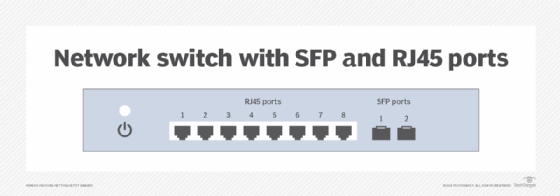
Alex - stock.adobe.com
An introduction to SFP ports on a Gigabit switch
SFP ports enable Gigabit switches to connect to a variety of fiber and Ethernet cables and extend switching functionality throughout the network.
Small form-factor pluggable is a hot-swappable interface used to connect network and storage switches and transfer data. Switches with SFP ports can connect to fiber optic and Ethernet cables of different types and speeds.
Almost all enterprise-class network switches include two or more SFP ports. This feature enables the connected switches to create a ring- or star-based network topology spread among different buildings, floors or areas, connected via network cables.
An SFP module, or transceiver, acts as a converter between the network switch and a fiber optic or Ethernet cable. For example, it converts electrical signals to optical signals for fiber optic cabling, and vice versa. SFP modules can also work with RJ45 connectors to support copper Ethernet cables. They support various transmission distances and data rates, enabling high-speed data transfer.
The Small Form Factor Committee, a group consisting of major equipment vendors, created the SFP specification and first published it in 2001. SFP modules built to the initial specifications support data rates of up to 1 Gbps. The specification has since been updated to support increased data rates.
What media types does SFP support?
SFP modules support single and multimode fiber optic cables and Cat5, Cat6, Cat6a and Cat7 twisted-pair copper. SFP modules designed for fiber support a variety of wavelengths and distances, typically up to 550 meters (m) with multimode fiber and 80 kilometers (km) with single mode.
Ethernet connections using Cat6a are limited to distances of approximately 100 m, but cross-talk between adjacent cables can limit the maximum distance. Cat7 cables include additional shielding to reduce cross-talk, but they can be difficult to install due to increased cable thickness.
The enhanced SFP (SFP+) specification was released in 2006 with a further update in 2011. SFP+ modules support the following data rates:
- 1 Gbps. Many SFP+ modules are backward-compatible with SFP transceivers that support slower data rates.
- 10 Gbps. This is the standard data rate for SFP+ modules, common in 10 Gigabit Ethernet (GbE) networks.
- 16 Gbps. SFP+ modules are specified for Fibre Channel (FC) at up to 8 Gbps, with some vendors supporting up to 16 Gbps.
Like the earlier SFP model, SFP+ modules support both fiber and copper, but copper interconnects are limited to 10 m at 10 Gbps. The SFP+ specification supports single-mode fiber interconnects to 80 km, with some multimode support for distances up to 300 m.
SFP+ also supports WAN connections based on optical transport network specification OTU2. This feature enables the transport of 10 GbE over long distances in optical networks.
Some SFP modules, such as GLC-BX-D and GLC-BX-U, support digital optical monitoring. This monitoring lets end users monitor SFP performance in real time, tracking metrics such as temperature, optical output power, optical input power, transceiver supply voltage and laser bias current.
SFP ports vs. RJ45 ports
While SFP and SFP+ modules are relatively inexpensive, 1 Gb and 10 Gb connections are more expensive than RJ45 connections. The RJ45 interface uses copper cables to connect to network devices, which is generally less expensive than fiber.
RJ45 ports are typically built into switches so customers don't need to purchase additional parts. Some Power over Ethernet switches have RJ45 ports that support PoE, which enables network cables to carry electrical power, in addition to data. In contrast, most SFP ports don't work with PoE, focusing only on data transmission.

The decision of when to use an RJ45 port or an SFP port on a switch depends on the distance between the connection endpoints. If the endpoints are close enough to use copper, then it might be more practical and cost-effective to use RJ45. If the distance is great enough to require fiber, then teams should use SFP ports. Fiber is also a better choice where cables must run side by side for a distance that makes cross-talk between copper cables an issue.
Combo SFP ports on a switch offer support for both SFP and RJ45 ports using a single interface. Users can't use both ports simultaneously, however, as only one type works at a time. These combo ports enable IT teams to choose a connection type that best matches application, network, cost or distance requirements.
SFP types and updates
Vendors have continued to update SFP specifications to support higher rates and additional interconnect types. SFP28 supports 25 Gbps over both multimode and single-mode fiber, and it's backward-compatible with traditional SFP and SFP+.
Bidirectional (BiDi) SFP supports bidirectional communication over a single fiber. While other SFP types require two fibers -- one to send and one to receive -- BiDi SFP uses different wavelengths to transmit and receive data signals.
Compact SFP supports two bidirectional links using the same interface module -- two fibers are used, with each carrying bidirectional traffic. Quad SFP modules support four fibers carrying Ethernet, FC or InfiniBand. Most available QSFP modules support data rates up to 200 Gbps for four channels. Octal SFP and QSFP double density have recently become available and extend data rates to 400 Gbps.
Currently, 400 Gbps is the highest data rate available in commercially available SFP products, although work is underway to develop standards and products that support 800 Gbps. SFP technology has demonstrated the ability to evolve as demands increase and will likely continue to evolve to support higher rates.
Editor's note: This article was originally written by Chris Partsenidis and updated by David Jacobs and editors to reflect technology developments and improve the reader experience.
David Jacobs has more than 30 years of networking industry experience. He has managed leading-edge software development projects and consulted Fortune 500 companies, as well as software startups.
Chris Partsenidis is founder and editor in chief of Firewall.cx.







